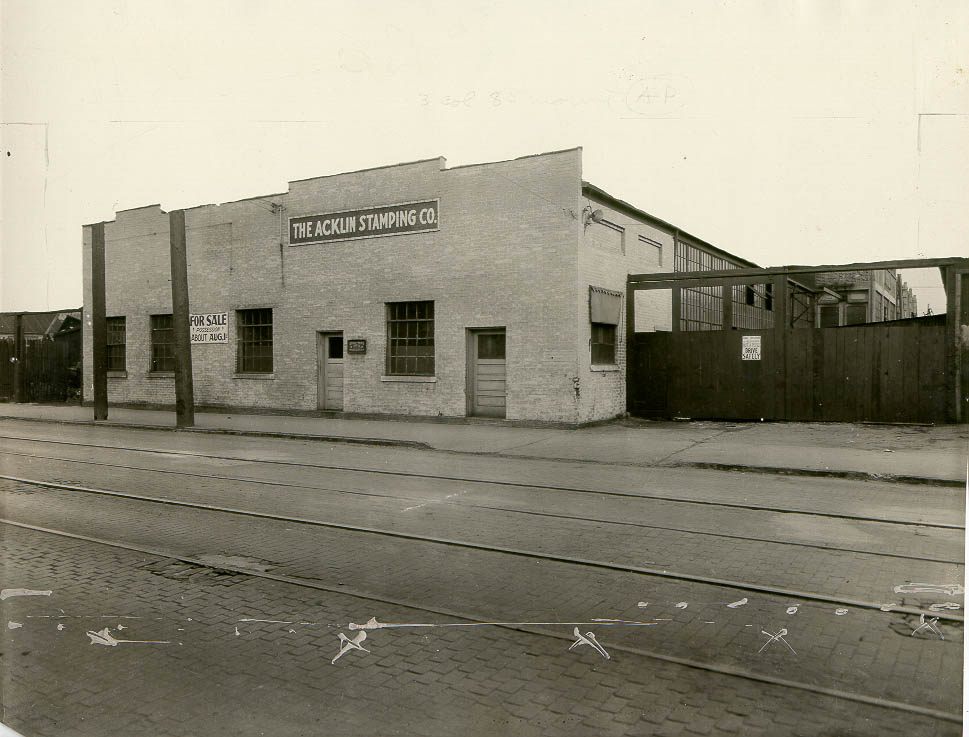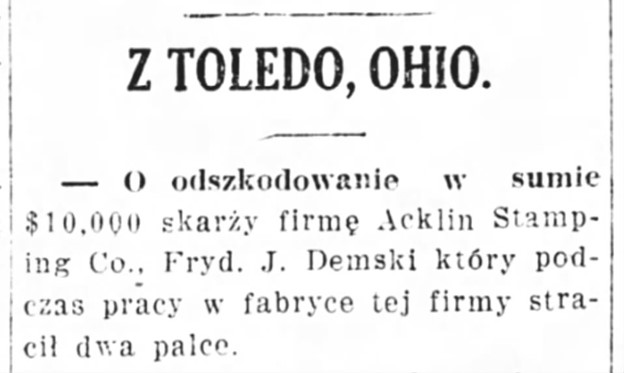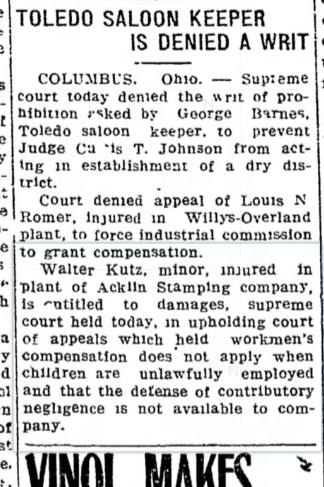Industrial Accidents, Our Ancestors’ Occupational Hazards
While researching my Przybylski line, I had discovered that Stanislaus Przybylski, son of Andrew and Frances Rochowiak, died in what was a frightful industrial accident. Stanislaus was a die setter for Acklin Stamping and on 26 June 1919, he died due to an accidental amputation of his right leg in a stamping press. Stanislaus was just 28 years old and left behind a wife, Helen Lawecka, and five children, the eldest about 10 years old and the youngest just a year old.
Acklin Stamping was started in 1911 by Grafton Acklin after he had retired from Toledo Machine and Tool. Acklin started the business with his three sons and it primarily focused on providing metal parts for the auto industry. Overland was a primary customer of the Acklin in the early days and its customer base grew so that Acklin was producing goods for World War I war efforts and parts for consumer goods such as lawn mowers. Acklin’s original location was on Dorr Street and moved to Nebraska Ave. in 1925. I noted a fair number of my ancestors as having worked at some point in their lives at Acklin–it was a fairly significant employer in Toledo through the late 20th century.

When I discovered Stanislaus’ accidental death, it made me curious about a couple of things because there was a strike in 1934 at Auto-Lite that was violent and was a major story in the history of unionization in this country. My first question was how many years’ of industrial accidents and safety issues at Acklin preceded that very violent strike at Auto-Lie in 1934; and secondly, what could I find in newspapers from about 1910 through 1940 regarding Acklin Stamping particularly? (Side note: I am researching the Auto-Lite strike and hope in the future to write a longer story about that history and what happened and what caused it and how it may have affected Polish Americans in the Toledo area.)
It appears as if industrial accidents were the norm not only at Acklin but throughout the nation in that period–it was one of the issues that had pushed the demand for unionization by labor during that period. While it was hard to find specific data on Acklin itself in the newspapers, a couple of small stories cropped up in my searches and tons of state-level and national data and stories appeared that described how dangerous it was to work in factories during this time.

Two Acklin incidents were in the newspapers before 1919. The first was about Fred J. Demski. Fred sued for $10,000 in damages for two lost fingers in 1913 and won his civil case. The Dziennik Chicagoski published this bit on 20 February 1913. Frank was to go on to serve in in World War I in France as part of the American Expeditionary Forces and died of wounds from battle on 6 October 1918.

The next incident that I could locate through a newspaper search was published in the Lima News on 3 April 1918. The Ohio Supreme Court decided that a minor named Walter Kutz who worked at Acklin was entitled to $10,000 for damages, upholding a ruling in the court of appeals. The reasoning was that workmen’s compensation was not applicable when children were unlawfully employed. I was unable to find further detail on either of these cases, but given some national news I ran across, it was fairly apparent that a factory job wasn’t terribly safe around the time the Stanislaus died. In fact, in the 1920, ads were run nationally for insurance policies covering industrial accidents.

Without being able to survey court records for these types of incidents, I was limited to what I could find in newspapers. Two incidental stories beyond my grand uncle’s death were enough for me to consider that factories were not a safe place for workers for quite some time, that safety was merely a talking point for industry and something not taken seriously. However, I was able to come across studies that were reported on in the newspapers of that time that reflected trends across Ohio and nationally before 1934.
In 1911, The Springfield News-Sun undertook researching the effects of industrial accidents. In an article published 9 February 1911, “The Aftermath of Industrial Accidents,” the News-Sun determined that after an accident and the wife or children took up the financial slack of supporting the home (but the husband survived but permanently disabled), a family’s income decreased by 65%. A study done in Pittsburgh during the same period that showed in 52% of accidents that ended in the death of the breadwinning husband, the widow and her family were left to bear the entire cost of the loss and there was no financial compensation. It was only in about 17% of these cases where there was some financial compensation, generally less than $500 (about $15.5K in today’s dollars).
Of 467 families who lost their husband/father to an industrial accident in this 1910-1911 study, 44 of the families, about 10%, had to rely on charity for the funeral expenses. Nineteen of these families returned to Europe so that they could have a family support them. Remarriage for the widow was not always the solution: if she had a large number of children, it was harder to find a single man who could take up the burden of raising a family. Fortunately for Helena’s family, after Stanislaus’ accidental death, she was able to remarry. Helena married James Spychalski in 1922 and they were able to raise Helena’s five children together. While Helena was fortunate to have been able to re-marry and maintain her family, not all widows were able to do this nor were all families able to easily recover from loss of income due to injury or loss of a breadwinner to to death.
In 1915, the Ohio State Industrial Commission issued a bulletin in Montgomery County (Dayton region) that stated for the last six months of 1914, over $57,000 was paid out to workers or their survivors for injuries, funeral costs, and medical and hospitalization costs. In 2022 dollars, this is over $1.7M! Per an article in the Dayton Daily News on 11 April 1915, hundreds of accidents were due to boring, drilling, and reaming machines as well as saws and grinding and polishing machines. The state estimated that during the last six months of 1914, the losses were equal to idling 430 men over that period–in Montgomery County alone.
In 1924, the movement for safety in industrial working environments gained some momentum. A national “No Accident Campaign” was started at a Safety Congress held in Louisville, Kentucky. At this Congress, Ernest Augustus of Mead Paper clearly pointed to a lack of data and support from both industry and the government for making jobs safer in factories and industrial environments in a speech he made to the Congress.
“We are surrounded and bewildered by a constantly rising mist of slogans and campaigns, and drives, and estimates. I have seen estimates by our very best authorities which fixed the number of fatalities annually in industrial accidents annually at 12,500, 25,000, and 35,000… The experts of the Bureau of Labor have estimated fatalities at about 21,000. We say that such information as we have indicates that there are 2,455,418 industrial accidents annually with a resulting loss of $1,022,264,866. (Yes, in 1924 dollars, that amount stated is in the billions!) Truly these figures are appalling. “
Mr. Augustus went on to propose
“…to ask the Federal Government for the authority, the man, and the money to enable us to undertake real industrial safety research work in the Department of Labor either through the present Bureau of Labor statistics or some other agency. I am having legislation draft, which will accomplish this end, and whish I propose to submit to the proper committee of the House and Senate when the Congress convenes this winter.”
I have not found any legislation that would have been presented to Congress in 1924 by Mr. Augustus, but his ideas were documented two years later in the 1926 Transactions of the National Safety Council for the Fifteenth Annual Safety Congress, Volume II Industrial Sections. He was reporting to the Safety Congress about his efforts to find the resources to put out a publication on plant safety.
In 1930, the State of Ohio Industrial Commission published that there were 99 fatal industrial accidents in December of 1929. The numbers were on the increase, this was 8 more than November 1928 and 4 more than in December 1928. The majority of the accidents were due to machinery, motor vehicles, or blast furnaces.
So, how did this all affect Toledo’s Polish community? A large number of the community were factory laborers, day laborers, or working in some type of factory or production facility. They were at risk for injury or accidental death, and families suffered when their breadwinner lost wages due to injury or would completely lose their incomes due to accidental death of the breadwinner. Much of this situation did come to play in the 1934 Auto-Lite strike, a violent strike that included the National Guard. Workers were not just protesting for better pay and better hours. They were striking for their lives–for safety. Before the strike, working and safety conditions in Toledo’s many factories were usually deplorable. Unskilled or semi-skilled workers were viewed as disposable–factory supervisors had a long list of men looking for work and could arbitrarily select who would work that day or not. It mattered little whether the men had safety equipment or were trained on use of the equipment and any safety measures needed. The Great Depression enhanced this situation. Families were desperate for income. Polish families weren’t unique in this situation–labor conditions and the Great Depression affected nearly every segment of this country. However, immigrant families were among the most vulnerable during the Industrial Revolution through the Great Depression as they often were those who provided the manpower to build the auto industry, man railroads, and mine coal. Unfortunately, while there was talk in industries about safety, it did not become a large concern for some companies until after the 1934 Auto-Lite strike. That strike was not just about safety, it was about wages as well, but we can easily see what built up to cause that deadly strike.